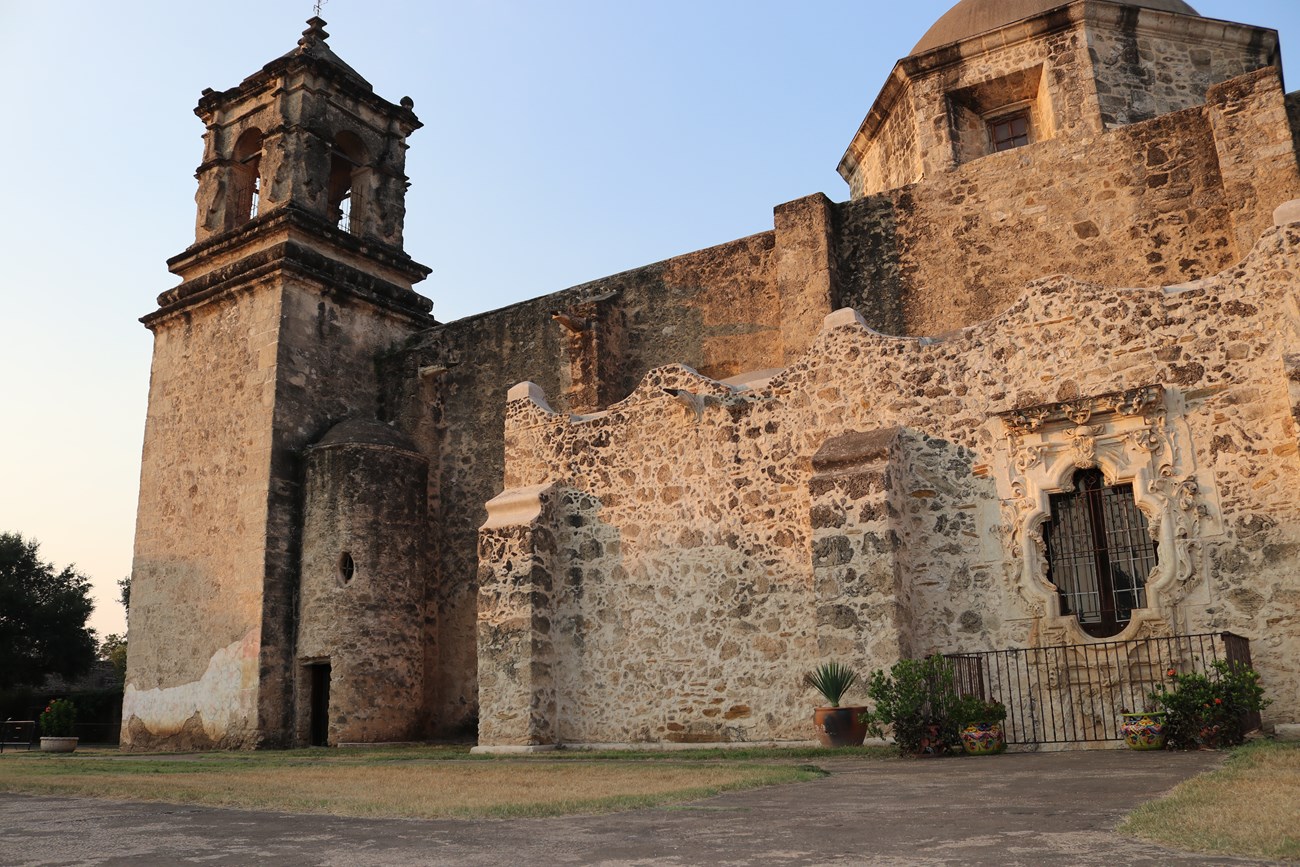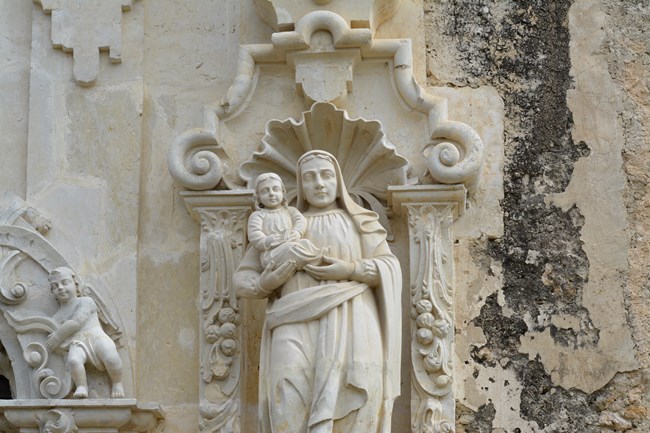
NPS Photo /Chantelle Ruidant-Hansen About Mission San José y San Miguel de AguayoKnown as the "Queen of the Missions", this is the largest of the missions and was almost fully restored to its original design in the 1930s by the WPA (Works Progress Administration). Spanish missions were not churches, but communities with the church the focus. Mission San José captures a transitional moment in history, frozen in time.
Founding the “Queen of the Missions” In 1719, Father Margil de Jesús, a seasoned Franciscan missionary, was at Mission San Antonio de Valero (today’s Alamo), awaiting the opportunity to re-establish missions in east Texas. Before too long, he saw need for another mission in the San Antonio River valley. He wrote the Marqués de Aguayo, then governor of the Province of Coahuila and Texas, requesting permission to establish a second mission south of San Antonio de Valero. He felt he was prepared to establish this mission at once as he had necessary church goods with him, even a statue of Saint Joseph. The Marqués agreed and founding ceremonies took place on February 23, 1720. On February 23, 1720 the Writ of Possession was signed for this mission, read the Writ of Possession here. Leaders of three Indian bands that wanted to come into the mission were appointed governor, judge, and sheriff in the new community of San José y San Miguel de Aguayo. Father Margil entrusted the care of the project to Father Núñez and two soldiers. The building of the limestone church, with its extraordinary Spanish colonial Baroque architecture and statuary began in 1768 — the peak of this mission’s development. At that time there were 350 Indians residing in 84 two-room apartments. Based on Father Morfi’s description of what he saw here when he visited in 1777, the church of Mission San José came to be known as the “Queen of the Missions.” neophyte noun, a person who is new to a subject, skill, or belief.
A Day at Mission San José in 1778 The mission’s objective was to convert Indigenous hunters and gatherers into Catholic, tax-paying subjects of the King of Spain. The native families struggle for survival in their quickly changing environment led them to the missions. Everything changed for these neophytes: diet, language, clothing, religion, culture — even their names. The neophytes’ new roles and duties in the mission were very regimented. Everyone undertook religious instruction daily. Church bells called them to worship three times a day. Following sunrise mass, families returned to their quarters for corn atole (mush) and charque (jerky). After breakfast, the men and boys worked in the labores (fields), and in their new trades of textile, tailor, carpenter, and blacksmith. They also worked as masons, weavers, acequia (irrigation ditch) builders, and at the lime kilns. Some took charge of the livestock at the mission’s ranch, El Atascoso, about 25 miles southwest of the mission. The women and girls prepared food, swept the dirt floors, carded wool, and fished in the irrigation ditch outside the walls, in addition to raising children. Everyone helped at harvest time in the farm fields. The bells rang out at noon, calling everyone back to the church for prayers. The main meal of the day was lunch, perhaps a bowl of goat stew and fresh baked tortillas. The afternoon siesta followed the meal and most activity subsided for several hours. Armed mission residents, however, continually kept guard outside the walls. After dinner, recreational time for singing, games, dances, storytelling, and drama filled the evening. The next work day began at sunrise to start the regimented routine all over again. A Community Continues On February 29, 1824, Mission San José ceased to be a mission. It was fully secularized that day when Father Díaz complied with Mexican government orders. He turned church property over to the mission Indians living here. After secularization, the mission was neglected. In the years following, Benedictines, Redemptorists, and Holy Cross Fathers ministered from the ruins. In 1931, the Franciscans returned and still live here today. The 104 years that San José operated as a mission, over 2,000 Indigenous were baptized. Today, families that worship at Mission San José continue in the faith taught to the mission Indians. Many hearts and hands played part in preserving and restoring the “Queen of the Missions”. Today, the National Park Service preserves and protects the living cultural heritage, the stone structures and irrigation systems that these Indigenous mission residents built. This ensures that future generations visiting will see how the past has shaped the present. The colorful culture, art, food, celebrations, and architecture we enjoy in San Antonio today emerged from the blending of Spanish and Indigenous traditions that took place here in the missions of San Antonio about 300 years ago. 
NPS Photo. Teaching With StoneThe beauty of the church at Mission San José has been recognized for centuries. Today, visitors enjoy the artistry that remains on this magnificent structure. In the past, the colorful frescoes and elaborate stone work also served a functional purpose. Within the intricate stonework of the facade, the colonial artist placed symbols of Catholicism and Spanish culture. Some symbols may have had meaning only to the artist or the Indigenous inhabitants of the mission. Most, however, are rooted in the long traditions of the Christian faith.Learn more about the stone imagery on this webpage.
NPS Photo The Rose Window is known as the premier example of Spanish Colonial ornamentation in the United States. Its sculptor and significance continue to be a mystery. Folklore credits Pedro Huizar, a carpenter and surveyor from Spain, with carving the famous window as a monument to his sweetheart, Rosa. Tragically, on her way from Spain to join him, Rosa was lost at sea. Pedro then completed the window as a declaration of enduring love. A less romantic, but more likely theory is that the window was named after Saint Rose of Lima, the first saint of the New World. Mission San José Map
NPS Want to learn more? Follow along with our cell phone tours and learn more about this site. Audio tour produced by the City of San Antonio World Heritage Office. Also visit the History & Culture page on Mission San José to dive deeper into the historical significance of this place! Mission San José Grist Mill |
Last updated: June 6, 2025
